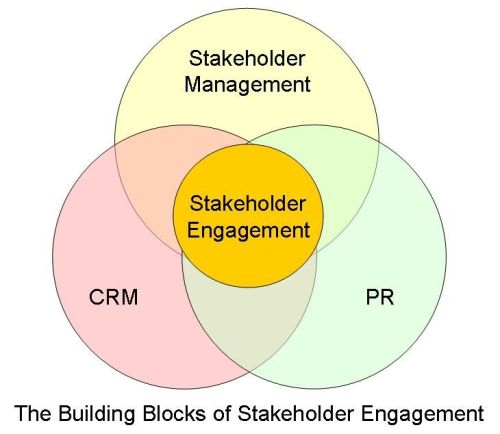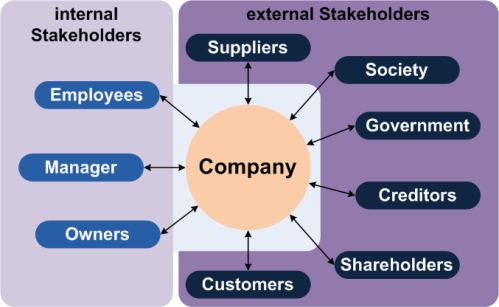Effective stakeholder engagement is a two-way interactive relationship that encourages stakeholder involvement in the organisation for the benefit of both the stakeholders and the organisation. The trend is increasingly clear; organisations that effectively serve the needs of their stakeholders outperform those that do not.
However, what is also apparent is confusion on the part of many managers as to precisely what stakeholder engagement is, and what systems facilitate effective stakeholder engagement. This post suggests there are three basic systems that together form the foundation for effective stakeholder engagement in most organisations, but the foundations are just that, necessary underpinnings, stakeholder engagement itself rises above the foundations to create an entirely new way of engaging with stakeholders. Let’s start with a look at the three basic components:
PR = Public Relations
PR is probably the oldest of the three foundations (particularly if you include advertising within the overall ambit of PR). For thousands of years people and organisations with something to sell to ‘the public’ have recognised the need to tell potential customers about their offering and suggest there is a good reason for the potential customer to become an actual customer or client.
Smart merchants realised they needed to give potential customers a reason for doing business with them (rather than someone else) and that competing on price alone was not a good move in a crowded market place.
The role of advertising is in part to make potential customers aware of your offering and in part to create a desire for the type of goods or services you are providing. Effective advertising creates a ‘call to action’ which the customer heeds.
Public Relations (PR) has a different focus. Good PR is built around creating a positive image of the organisation in the minds of its wider stakeholder community. PR is not directly aligned to sales in the way advertising is, but does seek to make the organisation appear to be one that most stakeholders in its target audience will want to be associated with. This may be because of exclusivity, or status, because the organisation is seen to be ‘good’, or for any one of a dozen other reasons. Effective PR has many purposes including:
- Underpinning its advertising by creating a ‘good first impression’ of the organisation, thereby allowing the stakeholder to take note of its advertising.
- Explaining the value of the organisation to a wider community minimising resistance to the functioning of the organisation and facilitating its operations.
- Making the organisation appear to be a desirable ‘citizen’ within its community; etc.
Good PR is of course authentic and reflective of the true nature of the organisation, in the modern age ‘spin’ is easily uncovered and can be very damaging.
The fundamental nature of both PR and advertising is ‘push’ communication – the organisation pushes its message out to the wider community, hopes someone listens, and then measures its impact after the event with a view to improving the ‘message’ and the effect.
CRM = Customer Relationship Management
CRM is focused on providing a great experience to every customer. The commercial driver for CRM is in part the generally accepted fact that it is far cheaper to retain an existing customer then to attract a new one and in part from a win-win view that the ability to quickly and efficiently service the unique needs of each customer reduces the transaction costs for the organisation.
Customers or clients are clearly stakeholders with a significant interest in the organisation, so focusing effort on providing them with the best possible level of service, delivered quickly and efficiently is a win-win outcome. Happy customers are more likely to recommend an organisation to their friends and colleagues as well as becoming regular clients of the organisation.
Unfortunately the concept of CRM seems to have been hijacked by software systems, overseas call centres and ‘big data’; bought with a view to ‘reducing costs’. There’s nothing wrong with any of these concepts provided the outcome is improved customer service. Where the outcome is a reduction in service, any cost savings are likely to be offset by reduced business and the cost of attracting new customers to replace the ones lost by poor service.
Whilst CRM at its best is interactive and focused on a win-win outcome for both the organisation and its stakeholders, the stakeholders directly affected by CRM are limited to the organisations customers and clients.
Stakeholder Management
Stakeholder management is process focused; it involves planned interaction with a wider stakeholder community, both to manage the consequences of any crisis as well as providing information and facilitating two-way communication with key stakeholders.
Good stakeholder management is a proactive process, focused on facilitating regular communication and anticipating needs, issues and problems that are likely to arise within the stakeholder community. Tools and methodologies such as the Stakeholder Circle® are designed to facilitate efficient stakeholder management. Stakeholders are identified, there needs assesses and their relative importance determined. Based on this assessment, communication and other interactions are initiated to gather the support and assistance needed by the organisation and to head off or minimise any threats or problems.
The focus of stakeholder management tends to be ‘defensive’, and is aimed at creating the best possible stakeholder environment to allow the organisation to do its work efficiently The process is interactive, seeking to engage constructively with the organisations stakeholders and looking for win-win outcomes that benefit the organisation and the stakeholder, but is driven by the organisation, from the perspective of the organisation.
Stakeholder Engagement
Stakeholder engagement builds on these three foundations (particularly ‘stakeholder management’) to create a different paradigm. Stakeholders are encouraged to actively engage with the organisation and contribute to its growth and development whilst at the same time the organisation and its staff engage with their community through Corporate Social Responsibility (CSR) initiatives and the like. These engagement processes build a strong, two-way relationship in which the stakeholders and the organisation work together to build a common future that is both mutually desirable and beneficial. I will be writing about stakeholder engagement in a future post.
Conclusion
The three foundations of Stakeholder Engagement: ‘Stakeholder Management’, CRM and PR are quite different processes focused on achieving different outcomes. In a well managed organisation all three functions work together to crate a supportive stakeholder environment and a successful organisation. However, whilst the systems need to be aligned and compatible they are very different and should not be confused.
In particular CRM and Stakeholder Management systems have very different objectives, focus on quite different stakeholder groupings, need significantly different information sets, and have very different measures of success:
- CRM focuses on customers (or clients). Whilst customers as a ‘class’ of stakeholder are important, generally an individual customer is not. The focus of a CRM system is managing large amounts of data to provide ‘all customers’ with a generically ‘good’, potentially ‘tailored’ experience.
- Stakeholder Management focuses on indentifying the key stakeholders ‘at this point in time’ that require specific management focus as well as the wider group of stakeholders that need to be engaged (or at least watched). In most situations very few individual clients or customers would be sufficiently important to feature in this list, but there will be lots of stakeholders who are highly unlikely to ever become ‘customers’, for example suppliers and competitors.
The shift to ‘stakeholder engagement’ does not add new systems but does require a paradigm shift in thinking. The key element of stakeholder engagement is opening up to the ‘right stakeholders’ and either inviting them into the organisation, or reaching out to them, to help create a mutually beneficial future – more on this later.








